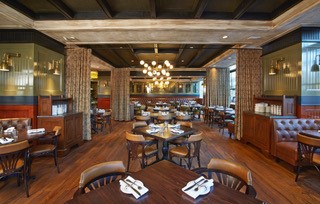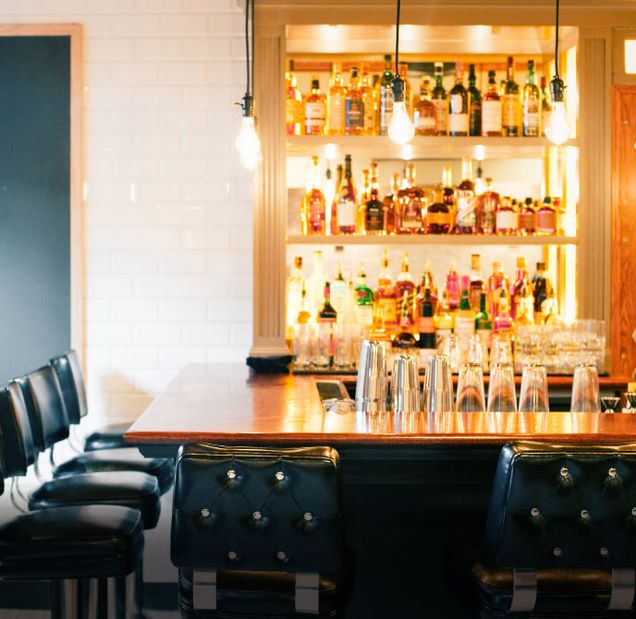My Head in the Clouds (computing): A Case Study of a Restaurant Group Embracing Off-Site Technology
![]()
By Tyler Titherington
I am a restaurateur. I’m behind schedule. Again. Not because I am disorganized or have too much to do, more so because I have a hierarchy of tasks that are addressed based on priority. Guest needs are my first priority, staff needs are a close second and everything else last. There is a tertiary hierarchy in the last basket as well. Some tasks with a lower priority fall through the cracks. Not because they are unimportant, but rather there just was not enough time. The truth is that I am obsessively organized. I love “To Do” lists, calendars, flow charts and the accomplishment of tasks. I eat projects for breakfast, while living on the edge of chaos and complete catastrophe. Short staffed? Yawn. Drains flooding? Been there, done that. POS system crash during service on a weekend? Bring it. I am the duck – calm above water and feet moving nonstop below. However, how do I manage all the curveballs and still manage to gain time without compromising any of my other priorities? It is very simple – adapt and embrace technology wherever possible, specifically, cloud-based computing solutions that allow one to be in many places at one time. These applications simplify daily tasks for management teams and staff, which will ultimately leverage senior management down to focus on the bigger picture. Maybe even get a day off…
Over the last 10 years or so, the increased availability of cloud-based computing solutions (using network computers over the internet rather than property-based hard drives) has been a major paradigm shift for many industries. However, as with most technological advances, the restaurant industry has been very slow to adapt. Tight margins, resistance to change, and fear of unknown outcomes have long driven the restaurateur’s decision-making process. However, with increased options, cheaper costs, and ease of use, that mindset is quickly becoming a thing of the past. Restaurant operators are beginning to embrace cloud-based solutions for everything from Point of Sale and Tableside Payment to Menu Design and Scheduling.
Our foray into cloud computing began with an unfortunate set of circumstances that the entire industry was facing. The year was 2010 and the impending doom of PCI Compliance was upon us. At best, our network infrastructure was dated and we needed to act quickly to get it into compliance. Like most operators, our hand was forced and we had no choice. What is PCI Compliance? The answer depends on who you ask.
![]()
Your guests have never heard of it and have no idea what it is. Most restaurant operators will tell you that PCI Compliance is an almost unachievable set of network security standards designed to protect the credit card giants, who already charge them way too much for credit card processing and continually squeeze them with a plethora of monthly fees. The definition of PCI Compliance is below, according to PCI ComplianceGuide.org
“The Payment Card Industry Data Security Standard (PCI DSS) is a set of security standards designed to ensure that ALL companies that accept, process, store or transmit credit card information maintain a secure environment. The PCI Security Council Card focuses on improving payment account security throughout the transaction process. It is an independent body that was created by the major payment card brands (Visa, MasterCard, American Express, Discover and JCB.).”[i]
PCI DSS is mandatory for any and all businesses that accept credit cards. It involves a process of assessment, remediation and reporting. Operators must identify network vulnerabilities, physical vulnerabilities, and operational vulnerabilities that could result in a credit card breach and fix them. In summary, it is a painfully tedious, extremely time consuming, and potentially expensive process.
It is extremely important for the security of our guest’s payment information, both for ensuring trust with our customers and limiting legal liabilities. In 2017-8, major retail stores including Home Depot, Macy’s, Sears, Kmart, Best Buy and Lord & Taylor made headlines across the country for data breaches possibly compromising customer’s credit card personal information. The restaurant industry is also plagued with security breaches, including large chains such as Darden (Cheddar’s), Panera Bread, Sonic and Arby’s. The number of customers whose credit card information may be compromised totals into the millions.[ii]
![]()
At Grafton Group, the process of obtaining Credit card security involved working directly with our IT vendor and POS vendor to achieve PCI compliance. The first order of business was to get our network infrastructure in order. Some of the major network upgrades that we undertook were upgrading wiring, locking down patch panels, securitizing external ports, adding wireless access points (WAPs), and replacing firewalls. The WAPs and new firewalls were the heart of the upgrades and would ultimately allow us to operate unencumbered in the cloud. The new access points give our guests their own network and prevent them from accessing ours. The security firewalls prevent intrusions and also allow our IT vendor remote access so they can make changes without actually being in the restaurant. What used to be a scheduled visit from our IT vendor that may have taken weeks, is now a simple email and can often be addressed online in minutes. In a nutshell, PCI DSS forced us to upgrade our network, which ultimately allowed us to operate in the cloud. This unintended outcome to a painful requirement was truly a blessing in disguise and it pushed us into new territory – the cloud! Being in the cloud has allowed us access to exciting applications and services that would otherwise be unavailable to us.
IBM defines cloud computing as “the delivery of on-demand computing resources — everything from applications to data centers — over the internet on a pay-for-use basis.”[iii] For our purposes, these on demand computing resources primarily consist of “SaaS” or Software as a Service. Here are some of the areas where cloud computing can streamline our operation.
Point of Sale
POS systems are the most interesting area of cloud-based solutions for restaurant operators. Legacy systems such as Positouch, Micros, and Aloha are bulkier, more expensive, and much harder to program and implement. There are quite a few cloud-based POS options, most notably Boston-based Toast. Toast has done a great job streamlining and simplifying the interface for both front and back end users. Management can access the system remotely for screen programming, troubleshooting or reviewing sales. It is extremely intuitive, like using a smartphone, thus needing very little training. As wireless POS solutions evolve, legacy systems will eventually be phased out. It is only a matter of time.
Tableside Payment
EMV (Europay, MasterCard and Visa) is another set of regulations that are coming to the restaurant industry. “EMV is a global standard for cards equipped with computer chips and the technology used to authenticate chip-card transactions.”[iv] Used in Europe for years, the credit card never leaves the customer and all transactions are processed tableside with a handheld device. One example of an EMV compliant, cloud-based device for tableside payments that we at Grafton Group are currently analyzing and plan on implementing is Pay My Tab. Pay My Tab will fully integrate with our POS system and eliminates many bulky PCI DSS requirements. Many similar systems are already in use at quick service operations, where guests and staff have easily adapted to them. In addition to tougher security, the implementation should decrease payment time, eliminate paper receipts (emailed instead) and simplify the process for management to search for specific receipts.

Reservations and Floor Management
There are a variety of solutions for reservations and floor management systems. Our firm has been using OpenTable for over 15 years, so when they rolled out their cloud-based system, GuestCenter, we were early adopters. This has been one of the single best applications in terms of roll out, ease of use, and seamless integration. It is iPad-based and eliminates all the wiring and host stand real estate. It is compatible to smart phones that allows for remote access, allowing management to check flow of service, identify unique reservations, and make sure that waitlists are being managed appropriately. Soon to come is an interface with POS systems that automatically applies any “guest notes” from GuestCenter to the server’s check, such as special occasions, etc. Most importantly, due to its intuitive design, our millennial hosts use the system seamlessly.
Private Event Management
Private events are the foundation of most full service restaurant operations. They are the difference between a good week and a great week. However, it can be a very confusing process with all of the moving parts. In order to stay organized, we use TripleSeat to manage leads, create BEOs and track our events calendar. The cloud-based event management system allows our Private Event Coordinators to respond at any given time from anywhere, giving them a leg up on the competition, giving them the opportunity to earn fees for each event. Since our coordinators receive an administrative fee for each event, they enjoy responding when available off-site; good communication is key for making sure work-life balance is maintained.
Bar at the Russell House Tavern in Cambridge, MA. Photo: graftongrouphospitality.com
Inventory
An area which the cloud has really saved our restaurants time is with food & beverage inventories. No more paper and no more transposing paper to spreadsheet. Inventories can be uploaded in real time using a tablet, laptop or even a smart phone. BevSpot is used for both our food and beverage inventories. We have also given access to our accounting firm, in order to reduce bulky invoice scans and uploads. All information can be entered into the cloud and accessed by all of our approved users. It also allows for multiple people to take inventory simultaneously. One person can be on the bar, another in the walk in fridge, and another in the liquor room, all at the same time. In addition to being a major time saver, it has helped Grafton Group to reduce sitting inventory by a significant amount across all properties.
Scheduling
Staff scheduling is a weekly administrative headache for managers, but there are cloud-based scheduling applications that lessen the pain. We have found HotSchedules to fit our needs as it interfaces with our POS system and allows our firm to do some creative reporting in regards to budgeting and forecasting, as well as taking employees requests and requirements into consideration.
Email and File Sharing
Grafton Group has come a long way from sharing access to a desktop version of Outlook and toggling between accounts. We were able to eliminate our main server entirely and now we use Office 365 for our email and file sharing needs. Not only is this highly securitized, it has redundancy so our information is always backed up. We access both our email and files from anywhere in the world. This has greatly improved productivity and allowed our management teams to communicate in real time.
Grafton Street in Cambridge, MA. Photo: graftongrouphospitality.com
Computer Hardware
Our office hardware now consists of much less expensive “Network Computers”, which do not require expanded memory for giant programs, CD drives for downloading drivers, or expansion slots for extraneous drives. We can purchase more computers at a reduced cost and our managers no longer have to share computer access in the office.
Menu Design
For our menu design need, we have found InDesign to be the most efficient program, which is part of the Adobe Creative Cloud. This program can now be selected a la carte from Adobe’s menu of programs and paid for on a month to month basis for under $20. This is much more palatable than paying $600 for the entire Adobe suite.
These are just a handful examples of how cloud computing has impacted our operations and ultimately saved time for our management team and staff. Ten seconds here, 5 minutes there, an hour tomorrow – it adds up to impactful chunks of time that can be better spent elsewhere. We have only scratched the surface as an industry – we will see more and more options for cloud-based solutions to real world restaurant problems. Although the solutions highlighted above create efficiency and save time, they do not serve guests and they don’t understand the art of hospitality. It is imperative that as restaurateurs we continue to create a positive environment, embrace innovation, and engage and train our employees in the art and skill of hospitality.
There are some things you will never have time for in the restaurant industry, regardless of cloud-based advancements. “Lunch”, for example, I have heard is a meal that takes place in the middle of the day. For me, “lunch” is the sandwich that I eat in 30 seconds somewhere between 2pm and 6pm standing over a trash can in the back of the kitchen. There is no technology for that…


20 comments
Nice Blog… thanks for sharing
Nice Blog thanks for sharing
Nice Blog Thanks for sharing
Great article, very in-depth
I believe this article will also help restaurant owners who don’t use online ordering to decide which ordering system works best for them: https://www.gloriafood.com/15-online-ordering-systems-for-restaurants. Just my two cents
https://www.gloriafood.com/15-online-ordering-systems-for-restaurants this one can help restaurants owners to decide which ordering system works best for them. Just my two cents
Thanks for sharing such a useful article. Food ordering and delivery software for restaurants . This can help you more…
Indolj is an online ordering system pakistan which enables restaurants to enable a digital menu on their websites which is 100% editable and comes with great flexibility. Indolj is one of the only platforms of its kind which provides the ultimate online ordering solution for restaurants. Its SEO friendly system allows you to put your restaurant on top of the results.
What if every system (pos, smart kitchen, order/receiving, etc etc) could be wrapped up into one service?
Nice. Interesting piece of read. Thanks for sharing!
Interesting piece of read. Follow us for more https://restaurant.favouritetable.com/
https://restaurant.favouritetable.com/ interesting, Do read to get some more insights on the topic.
Because I have a hierarchy what time do gas stations open
of tasks that are addressed based on priority. Guest needs are my first priority, staff needs are a close second and everything else last.
New strategy is filed for the comfort for the players of the game. The scope of the Beste powerbank of all offers. The margin is ensured for the approval of the oval means for all people. The stat up is done for theist of the turns for all tops.
Amazing post,
Also visit- Orion One 32 Noida
This case study illuminates a restaurant group’s seamless integration of cloud computing, showcasing how embracing off-site technology optimizes operations and enhances overall efficiency in the dynamic hospitality landscape. You can also visit my profile for the best Interior Designers in Gurugram
It’s great for gaming: nhà cái QH88
A case study is a detailed study of a specific subject, such as a person, group, place, event, organization, or phenomenon. Red Hat certified ( rhca )guys are highly sought after as the exams are performance based and the certificate proves that the candidate can perform day to day sysadmin tasks.
Cloud computing is a term that has gained widespread use over the last few years. With the exponential increase in data use that has accompanied society’s transition into the digital 21st century, it is becoming more and more difficult for individuals and organizations to keep all of their vital information, programs, and systems up and running on in-house computer servers (see report Benefits of Cloud Computing Technology for Insurance). The solution to this problem is one that has been around for nearly as long as the internet, but that has only recently gained widespread application for businesses.
Cloud allows network-based access to communication tools like emails and calendars. Wats app is also a cloud-based infrastructure as it comes in communication it is also one of the examples of cloud computing. All the messages and information are stored in service providers hardware.
There are 4 main types of cloud computing: private clouds, public clouds, hybrid clouds, and multiclouds. There are also 3 main types of cloud computing services: Infrastructure-as-a-Service (IaaS), Platforms-as-a-Service (PaaS), and Software-as-a-Service (SaaS).
Cloud computing technology gives users access to storage, files, software, and servers through their internet-connected devices: computers, smartphones, tablets, and wearables. Cloud computing providers store and process data in a location that’s separate from end users.
Nice post !
Bedroom interior design ideas